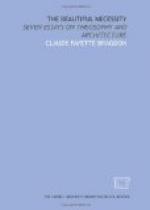III
CHANGELESS CHANGE
TRINITY, CONSONANCE, DIVERSITY IN MONOTONY, BALANCE, RHYTHMIC CHANGE, RADIATION
The preceding essay was devoted for the most part to that “inevitable duality” which finds concrete expression in countless pairs of opposites, such as day and night, fire and water, man and woman; in the art of music by two chords, one of suspense and the other of fulfilment; in speech by vowel and consonant sounds, epitomized in a and in m; in painting by warm colors and cold, epitomized in red and blue; in architecture by the vertical column and the horizontal lintel, by void and solid—and so on.
TRINITY
This concept should now be modified by another, namely, that in every duality a third is latent; that two implies three, for each sex so to speak is in process of becoming the other, and this alternation engenders and is accomplished by means of a third term or neuter, which is like neither of the original two but partakes of the nature of them both, just as a child may resemble both its parents. Twilight comes between day and night; earth is the child of fire and water; in music, besides the chord of longing and striving, and the chord of rest and satisfaction (the dominant seventh and the tonic), there is a third or resolving chord in which the two are reconciled. In the sacred syllable Om (Aum), which epitomizes all speech, the u sound effects a transition between the a sound and the m; among the so-called primary colors yellow comes between red and blue; and in architecture the arch, which is both weight and support, which is neither vertical nor horizontal, may be considered the neuter of the group of which the column and the lintel are respectively masculine and feminine. “These are the three,” says Mr. Louis Sullivan, “the only three letters from which has been expanded the architectural art, as a great and superb language wherewith man has expressed, through the generations, the changing drift of his thoughts.”
[Illustration 21: THE LAW OF TRINITY. A ROMAN IONIC ARCADE, BY VIGNOLE.—THE COLUMN, THE ENTABLATURE, AND THE ARCH CORRESPOND TO LINES VERTICAL, HORIZONTAL AND CURVED.]
It would be supererogatory to dwell at any length on this “trinity of manifestation” as the concrete expression of that unmanifest and mystical trinity, that three-in-one which under various names occurs in every world-religion, where, defying definition, it was wont to find expression symbolically in some combination of vertical, horizontal and curved lines. The anstated cross of the Egyptians is such a symbol, the Buddhist wheel, and the fylfot or swastika inscribed within a circle, also those numerous Christian symbols combining the circle and the cross. Such ideographs have spelled profound meaning to the thinkers of past ages. We of to-day are not given to discovering anything wonderful in three strokes of a pen, but every artist in the weaving of his pattern must needs employ these mystic symbols in one form or another, and if he employs them with a full sense of their hidden meaning his work will be apt to gain in originality and beauty—for originality is a new and personal perception of beauty, and beauty is the name we give to truth we cannot understand.




